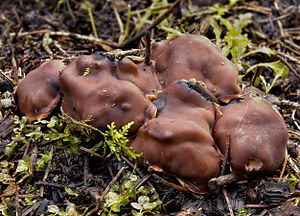Wavy root orchel
| Wavy root orchel | ||||||||||||
|---|---|---|---|---|---|---|---|---|---|---|---|---|

Wavy root orchel ( Rhizina undulata ) |
||||||||||||
| Systematics | ||||||||||||
|
||||||||||||
| Scientific name | ||||||||||||
| Rhizina undulata | ||||||||||||
| Fr. |
The wavy root orchel ( Rhizina undulata , Syn . : Rhizina inflata ) is the only species of its genus. The hose fungus from the family of the root orchel relatives (Rhizinaceae) grows on burns, attacks the root areas of conifers and causes wood rot there.
features
Macroscopic features
The irregularly cushion-shaped and bumpy-wavy fruiting bodies lying flat on the substrate reach a width of up to 12 cm and a height of about 5 cm. They are sessile, hollow on the inside and open at the bottom. The spore-forming fruit layer on the upper side is chestnut to black-brown in color, fruit bodies in the process of growth have a whitish to yellowish edge. The spore powder is white. On the whitish-pale yellow, later brownish underside, 1–2 mm thick root-like mycelium strands extend to the ground. The consistency of the meat is initially brittle, later tough and leathery. Smell and taste are unspecific.
Microscopic features
The cylindrical tubes measure 310-400 x 13-18 µm. The 25–33 µm long and 8–9.5 µm wide spores grow there. They are colorless, long-elliptical, pointed at both ends and filled with two drops of oil on the inside. However, the finely dotted surface of the spores can only be seen in a colored specimen. Between the tubes there are colorless, thread-like and slightly clubbed paraphyses that are stuck together with brown excretions. Those elements are also divided by transverse walls. Unseptated and brown-walled setae complete the structure of the fruit layer .
ecology
The wavy root orchel specializes in fire places and fire places. The parasite likes to grow in the root area of conifers and is also found on clear-cuts and in young spruce stands. As hosts are primarily Douglas fir , Sitka spruce and black pine in question, but also the Norway spruce , Canary pine , Scots pine and European larch belong to the substrate spectrum .
Initially, the spores rest in the soil. Only brief heating in the soil to a temperature of 38–45 ° C ends the dormancy and saprobiontic development begins . If the mycelium, which only spreads in acidic soils, hits the roots of susceptible host plants, it infects the root area and the wood begins to rot. The incubation period is 1–2 years. The fungus needs the same amount of time to develop the fruiting bodies.
distribution
The wavy root orchel is a widespread species of mushroom found in America, South Africa, Asia and Europe. The online mushroom mapping database contains a number of records from Bavaria and evidence from Lower Saxony. If the habitat is suitable, the fungus can also be found in other German federal states. In Austria it was found in all federal states except Tyrol and Vienna.
meaning
The wavy root orchel attacks various conifers and causes rot in the root wood, which in the course leads to a yellowing of the needles and a compression of newly formed shoots. Eventually the damaged trees die. Circular death gaps in the tree population, which expand over time, are also symptomatic. Clear evidence of an infestation are the fruiting bodies on the periphery of the infested sites and yellowish mycelial strands in the root area of the diseased trees.
Because it is tied to fire sites , the simplest prophylactic measure is to strictly avoid fire sites. In the event of an infestation, the mycelium can be prevented from spreading by digging trenches. However, this only leads to success in the early stages and with smaller death gaps.
swell
Individual evidence
- ↑ a b Ewald Gerhardt: Mushrooms . BLV, Munich 2006, ISBN 978-3-8354-0053-5 , p. 584 .
- ↑ a b Hans E. Laux: The new cosmos mushroom atlas . Kosmos, Stuttgart 2002, ISBN 978-3-440-07229-5 , pp. 288–289 (303 pages; over 1000 photos).
- ↑ J. H. Ginns: Rhizina undulata pathogenic on Douglas Fir seedlings in western North America . In: Plant Disease Reporter . tape 52 (7) , 1968, pp. 579-580 .
- ↑ a b c d Heinz Butin : Diseases of the forest and park trees. Guide to Determining Tree Diseases . 3. Edition. Georg Thieme, Stuttgart (D) / New York (USA) 1996, ISBN 978-3-8001-7636-6 , pp. 170-171 (261 pages).
- ↑ Peter Schütt, Horst Weisgerber, Hans J. Schuck et al: Lexicon of Conifers . Nikol, Hamburg 2008, ISBN 978-3-933203-80-9 , pp. 341-342 .
- ^ German Society for Mycology (DGfM): Distribution of Rhizina undulata. In: Pilzkartierung 2000 Online, edited by Axel Schilling and Peter Dobbitsch. 2004, accessed April 8, 2011 .
- ^ Austrian Mycological Society (ÖMG): Database of Austrian mushrooms. Edited by Wolfgang Demon, Anton Hausknecht, Irmgard Greilhuber. 2009, accessed February 23, 2012 .
Web links
- Jiří Laštůvka: Kudluv fotoatlas hub. Kořenitka nadmutá - Rhizina undulata (Czech)
- Marcel Lecomte: Galerie de Microscopie: Rhizina undulata (French)
- Jens H. Petersen, Thomas Læssøe: MycoKey: the species Rhizina undulata. (with SEM photo of the spores )
- Photo of the sociable bristle ( Trichophaea gregaria ) on wavy root orchel ( Rhizina undulata )

